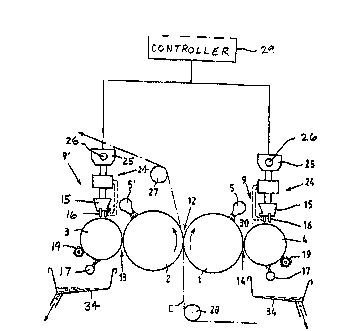Une partie des informations de ce site Web a été fournie par des sources externes. Le gouvernement du Canada n'assume aucune responsabilité concernant la précision, l'actualité ou la fiabilité des informations fournies par les sources externes. Les utilisateurs qui désirent employer cette information devraient consulter directement la source des informations. Le contenu fourni par les sources externes n'est pas assujetti aux exigences sur les langues officielles, la protection des renseignements personnels et l'accessibilité.
L'apparition de différences dans le texte et l'image des Revendications et de l'Abrégé dépend du moment auquel le document est publié. Les textes des Revendications et de l'Abrégé sont affichés :
| (12) Demande de brevet: | (11) CA 2124468 |
|---|---|
| (54) Titre français: | DISPOSITIF DE REVETEMENT EN CONTINU DE MATERIAU EN NAPPE |
| (54) Titre anglais: | COATING SYSTEM FOR COATING TRAVELING WEBS OF MATERIAL |
| Statut: | Réputée abandonnée et au-delà du délai pour le rétablissement - en attente de la réponse à l’avis de communication rejetée |
| (51) Classification internationale des brevets (CIB): |
|
|---|---|
| (72) Inventeurs : |
|
| (73) Titulaires : |
|
| (71) Demandeurs : |
|
| (74) Agent: | GOWLING WLG (CANADA) LLP |
| (74) Co-agent: | |
| (45) Délivré: | |
| (22) Date de dépôt: | 1994-05-27 |
| (41) Mise à la disponibilité du public: | 1994-11-28 |
| Licence disponible: | S.O. |
| Cédé au domaine public: | S.O. |
| (25) Langue des documents déposés: | Anglais |
| Traité de coopération en matière de brevets (PCT): | Non |
|---|
| (30) Données de priorité de la demande: | ||||||
|---|---|---|---|---|---|---|
|
ABSTRACT OF THE DISCLOSURE
The invention concerns a coating system with at least one
web support roll and at least one corresponding metering roll
coordinated with it and having a grooved surface essentially in
peripheral direction or in the form of a threading, for metering
the coating substance in the gap existing between the web support
roll and the metering rolls. A groove forming or groove truing
system can be infed in the operation of the coating system can
be infed onto the metering rolls.
Note : Les revendications sont présentées dans la langue officielle dans laquelle elles ont été soumises.
Note : Les descriptions sont présentées dans la langue officielle dans laquelle elles ont été soumises.

2024-08-01 : Dans le cadre de la transition vers les Brevets de nouvelle génération (BNG), la base de données sur les brevets canadiens (BDBC) contient désormais un Historique d'événement plus détaillé, qui reproduit le Journal des événements de notre nouvelle solution interne.
Veuillez noter que les événements débutant par « Inactive : » se réfèrent à des événements qui ne sont plus utilisés dans notre nouvelle solution interne.
Pour une meilleure compréhension de l'état de la demande ou brevet qui figure sur cette page, la rubrique Mise en garde , et les descriptions de Brevet , Historique d'événement , Taxes périodiques et Historique des paiements devraient être consultées.
| Description | Date |
|---|---|
| Inactive : CIB expirée | 2014-01-01 |
| Inactive : CIB de MCD | 2006-03-11 |
| Inactive : CIB de MCD | 2006-03-11 |
| Inactive : CIB de MCD | 2006-03-11 |
| Inactive : Lettre officielle | 1998-07-09 |
| Inactive : Lettre officielle | 1998-07-09 |
| Le délai pour l'annulation est expiré | 1998-05-27 |
| Demande non rétablie avant l'échéance | 1998-05-27 |
| Demande visant la révocation de la nomination d'un agent | 1998-04-03 |
| Demande visant la nomination d'un agent | 1998-04-03 |
| Réputée abandonnée - omission de répondre à un avis sur les taxes pour le maintien en état | 1997-05-27 |
| Demande publiée (accessible au public) | 1994-11-28 |
| Date d'abandonnement | Raison | Date de rétablissement |
|---|---|---|
| 1997-05-27 |
Les titulaires actuels et antérieures au dossier sont affichés en ordre alphabétique.
| Titulaires actuels au dossier |
|---|
| J. M. VOITH GMBH |
| Titulaires antérieures au dossier |
|---|
| JORG PICHLER |
| MARTIN KUSTERMANN |
| MICHAEL TREFZ |